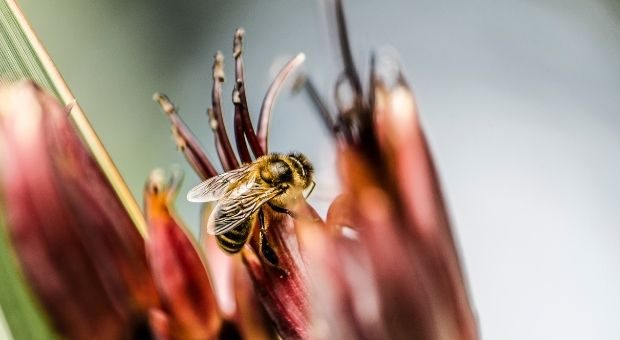02
Mar
Solitary Wild Bees Harmed by Neonicotinoid Pesticides Applied by Soil Drenching

(Beyond Pesticides, March 2, 2021) Populations of solitary ground nesting bees decline after exposure to neonicotinoid insecticides, according to a study published in Scientific Reports late last month. In addition to ground-nesting bees, neonicotinoids have been shown to harm butterflies, hummingbirds, songbirds, aquatic species and mammals, including humans. As independent science continues to look beyond the effects of these systemic chemicals on honey and bumblebees, advocates maintain that it has become increasingly clear that the high hazards presented by neonicotinoids necessitate their complete elimination.
“Farmers need to protect their crops from pests, but they also absolutely need to protect pollinators from the unintended effects of pesticides,” said study coauthor Susan Willis Chan, PhD. “The data on this particular [neonicotinoid] product are so clear that there’s really no question about what has to happen. We have to find something else.”
Researchers focused their effort investigating how various systemic pesticides effect the hoary squash bee (Eucera pruinosa), a ground nesting bee found throughout North America that feeds entirely on pollen from cucurbits (including squash, cucumber, pumpkin, gourds, etc). The hoary squash bee provides essential pollinator services for these crops throughout the U.S. and Canada. Neonicotinoids and other systemic insecticides are often applied in an attempt to manage cucumber beetles, which consume these crops and can spread disease to susceptible plants.
Systemic insecticides are generally applied one of three ways – either on the seed itself, as a soil drench during seeding, or as a foliar spray. Researchers established twelve hoop houses, planted them with squash, and applied a pesticide in one of the three ways described (with three hoop houses per group). Squash seeds were treated with the neonicotinoid thiamethoxam, the neonicotinoid imidacloprid was applied as a soil drench, and chlorantraniliprole was sprayed on plant foliage. A fourth group of hoop houses did not have a pesticide applied in order to act as a control.
Female squash bees were introduced to the hoop houses after mating, as soon as the squash crop was blooming. Researchers watched the bees’ progress through three key life stages: digging out and establishing a nest, foraging nectar and pollen for the nest, and laying eggs in the nest.
Results show that the soil drench presents significant hazards to ground nesting bees. Hoary squash bees in this group initiated 85% fewer nests, harvested 5 times less pollen, and produced 89% fewer offspring than the untreated control group. Although no measurable impacts were seen on the groups where thiamethoxam treated seeds or chlorantraniliprole foliar spray were used, scientists indicate this may be due the fact that pollinators were not active during time of application.
A journal article published in 2019 also found imidacloprid to be highly toxic to solitary ground nesting bees, and may provide clues to effects seen in the current study. In that study, researchers found that varying amounts of pesticide exposure had differing effects on the size and speed of development. Observed changes were likely the result of a hormetic response, a phenomena that results from exposure to pesticides where changes in development occur in order to compensate for energy the bee diverts into physical and biological protections from pesticide exposure.
Thus, it is possible that reductions in nest development, pollen collection, and brood rearing are a result of a hormetic response prioritizing other activities. However, it could also be that these effects are a manifestation of disruptions at the cellular level – whereby neonicotinoids damage the nervous system, leading insects to become blind.
Whatever the etiology of the deleterious effects observed, study authors are certain that their data points to unacceptable hazards from the use of imidacloprid. “Farmers and regulators need to look at alternatives to applying imidacloprid to soil for controlling pests on squash and pumpkins,” she said. “My recommendation to pumpkin and squash farmers is to stay away from imidacloprid applied to soil to keep their squash bees healthy.”
Researchers note that regulatory assessments are focused too closely on honey bees, and fail to consider risks associated with pesticide residue in soil. “Our results highlight why this should be changed to better characterize risk for the many bee species that spend a large proportion of their life in soil.”
While the European Union and Canada have followed the science and eliminated most uses of neonicotinoids, the U.S. Environmental Protection Agency continues to permit widespread use of these chemicals not only in cucurbits production, but in pollinator habitat throughout the country. Help institute a better framework for protecting pollinators by supporting the the Saving America’s Pollinator Act, which would eliminate the use of bee-toxic pesticides in the United States. Become active in your community and state by gathering together with like minded friends and neighbors, and reach out to your elected officials about this issue. Get familiar with the science through Beyond Pesticides past daily news posts as well as the Bee Protective webpage.
All unattributed positions and opinions in this piece are those of Beyond Pesticides.
Source: Scientific Reports, University of Guelph (press release)










